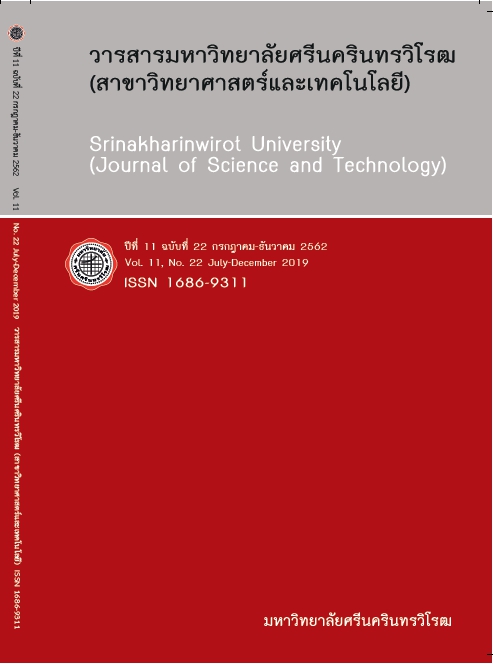การหาสภาวะที่เหมาะสมในขั้นตอนการเพิ่มจำนวนเพื่อปรับปรุงการคัดเลือกเชื้อลิสทีเรีย (MEDIA OPTIMIZATION OF ENRICHMENT PROTOCOL TO IMPROVE LISTERIA SELECTIVITY)
Keywords:
Listeria Selectivity, Listeria innocua, Enrichment Media, Selective AgentsAbstract
Listeria innocua growth and selectivity during selective enrichment step were studied to formulate fundamental knowledge to enhance Listeria spp. detection protocol. L. innocua was used in this study as a non-pathogenic Listeria model because it shares similar physiological traits with Listeria monocytogenes. TSB, an effective non-selective enrichment medium, was selected to enhance the growth of L. innocua in the selective enrichment step. The effects of conventional inhibitors were studied by using common selective inhibitors suggested in most global icrobiological detection standards (i.e., NGFIS, IDF, USFDA, NMKL, ISO, AOAC, and USDA-FSIS). The TSB broth base was modified by adding some conventional selective agents to study the growth and selectivity of Listeria spp. The growth profiles showed that acriflavine significantly affected the growth of Gram-positive bacteria. Polymyxin B inhibited Gram-negative bacteria as well as Gram-positive bacteria but to a lesser extent. As low as 10 mg/L of Polymyxin enabled effective reduction of E. coli from 6 to less than 2 log CFU/mL within 2 h of incubation. Nalidixic acid only suppressed Gram-negative bacteria and was not as effective as Polymyxin B. Although lithium chloride did not significantly affect the inhibition of any target microorganisms. Response surface analysis indicated that the optimum selective agents included 5.7 mg/L of acriflavine, 10.0 mg/L of Polymyxin B and 20.7 g/L of lithium chloride. This new media formula was proved to isolate E. coli and S. aureus from L. innocua.
Downloads
References
[2] Scallan, E; Hoekstra, RM; Angulo, FL; Tauxe, RV; Widdowson, MA; Roy, SL; Jones, JL, and Griffin, PM. (2011). Centers for Disease Control and Prevention. Author affiliation. 17(1).
[3] CBC News Canada. (2008). Number of confirmed cases, deaths linked to listeriosis increases. Retrieved from http://www.cbc.ca/news/Canada/story/2008/08/25/health-listeriosis.html
[4] Food Poisoning Attorney. (2011). The Food Safety Law Firm. Retrieved from http://www.billmarler.com
[5] Manolopoulou, E; Sarantinopoulos, P; Zoidou, E; Aktypis, A; Moschopoulou, E; Kandarakis, G, and Anifantakis, EM. (2003). Evolution of Microbial Populations during Traditional Feta Cheese Manufacture and Ripening. International Journal of Food Microbiology. 82, 153-161.
[6] W. Horwitz. (1990). Listeria monocytogenes in Milk and Dairy Products, Selective Enrichment and Isolation Method. In Official Methods of Analysis of AOAC International. 17th ed. Gaithersburg-Malylnad.
[7] T. Johansson, & S. Loncarevic. (2007). NMKL Method No.136 Listeria monocytogenes. Detection in Foods and Feeding Stuffs and Enumeration in Foods. 4th ed.
[8] Netten, P; Perales, I; van, de; Moosdijk, A; Curtis, G.D.W, and Mossel, D.A.A. (1989). Liquid and Solid Selective Differential Media for the Detection and the Enumeration of Listeria monocytogenes and other Listeria spp. International Journal of Food Microbiology. 8, 299-316.
[9] Jacobsen, C.N. (1999). The Influence of Commonly used Selective Agents on the Growth of Listeria monocytogenes. International Journal of Food Microbiology. 50, 221-226.
[10] Beumer, RR; Giffel; Kok, MCT, and Rombouts, FM. (1996). Confirmation and Identification of Listeria spp. Letters in Applied Microbiology. 22, 448-452.
[11] Curtis, G.D.W; Nichol, W.W, and Fall, S.T.J. (1989). Selective Agents for Listeria can Inhibit their Growth. Letters in Applied Microbiology. 8, 169-172.
[12] Besse, N.G. (2002). Influence of Various Environmental Parameters and of Detection Procedures on the Recovery of Stressed L. monocytogenes: a Review. Food Microbiology. 19, 221-234.
[13] Centers for Disease Control and Prevention. (2012). Multistate Outbreak of Listeriosis Linked to Imported
Frescolina Marte Brand Ricotta Salata Cheese (Final Update). Retrieved from www.cdc.gov/listeria/outbreaks/cheese-09-12/index.html
[14] Liamkaew, R. (2013). Novel, Rapid, and High-throughput Listeria Detection Method for Food Industry. Doctor of Engineering, Food Engineering, Faculty of Engineering, King Mongkut’s University of Technology Thonburi, p. 132.
[15] Vlaemynck, G; Lafarge, V, and Scotter, S. (2000). Improvement of the Detection of Listeria monocytogenes by the Application of ALOA, a Diagnostic, Chromogenic Isolation Medium. Journal of Applied Microbiology. 88, 430-441.
[16] Cornu, M; Kalmokoff, M, and Flandrois, J.P. (2002). Modelling the Competitive Growth of Listeria monocytogenes and Listeria innocua in Enrichment Broths. International Journal of Food Microbiology. 73, 261-274.
Downloads
Published
How to Cite
Issue
Section
License
Srinakharinwirot University Journal of Sciences and Technology is licensed Under a Creative Commons Attribution-NonCommercial-NoDerivs 4.0 International (CC-BY-NC-ND 4.0) License, Unless Otherwise Stated. Please Read Journal Policies Page for More Information on Open Access, Copyright and Permissions.



